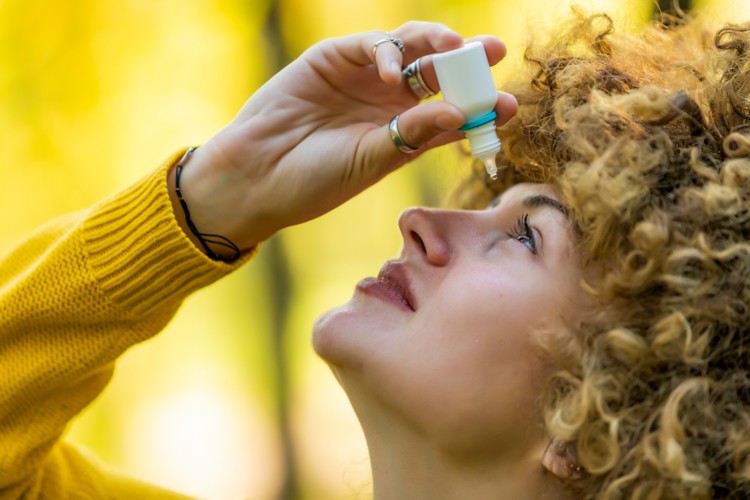Dry eyes are a frequent problem that can be caused by a variety of factors. They might be caused by age, environmental causes, or they can be an indication of another condition. Dry eyes can be relieved using gel drops, which are thicker forms of artificial tears.
Gel drops have a thicker consistency than other eye drops and tend to stay in the eye for longer.
For comfort and to replace eye moisture, people frequently use gel drops overnight. They might also give them a try if they’ve tried and failed with other dry eye treatments.
This page looks at what conditions gel eye drops cure, which OTC gel eye drops are available, the distinction between prescription and OTC eye drops, as well as adverse effects and interactions.
Conditions gel drops treat

Dry eye gel drops are used to address symptoms such as a lack of moisture in the eye or poor tear quality.
Tears spread across the surface of the eye when it blinks. The surface of the eye cannot sustain lubrication if the eye does not generate enough tears or if the tears are of poor quality. Dye eyes can cause the following symptoms:
- soreness
- red eyes
- blurry vision
- light sensitivity
- burning
- watery eyes
- itching
- a gritty feeling
Gel drops for dry eyes treat dryness or redness of the eyes due to several factors. Eye dryness may result from:
- wind, dust, cold, or dry air
- smoke or alcohol use
- certain medications
- some health conditions such as lupus or Sjögren’s disease
- aging
- contact lenses
- computer use
- air conditioning or heating
Available dry eye gel drops
There are a variety of over-the-counter eye drops available.
Artificial tears are designed to replicate real tears and are good for people who suffer from mild to moderate dry eyes.
Gel drops are artificial tears, but they are designed to stay in the eye for longer and to give more moisturization than other forms of artificial tears.
Gel drops, on the other hand, can cause temporary blurriness in vision until they settle into the eye. People with moderate-to-severe dry eye should use these drops.
The following are some of the most prevalent forms of over-the-counter gel eye drops:
- Refresh Celluvisc, which includes the active ingredient carboxymethylcellulose sodium 1%.
- GenTeal Tears, which contains the active ingredients dextran 70 0.1% and hypromellose 2910 0.3%.
- Systane, which contains the active ingredients polyethylene glycol 400 and propylene glycol 0.3%.
- Blink GelTears, which includes the active ingredient polyethylene glycol 400.
All of these gel drops are used to treat dry eyes caused by causes such as the environment, medications, or other conditions. They can also be used to treat red eyes and pink eye, which is commonly referred to as conjunctivitis.
Dry eye is mainly caused by a decrease in the quality or quantity of tear production. When some of the gel’s inactive chemicals, generally gelling agents, are exposed to the pH of the eye’s surface, they work to produce a matrix that coats the eye. This gives both protection and relaxation.
Over-the-counter vs. prescription
OTC dry eye gel drops will be the first line of defense in many cases of dry eye. However, because they momentarily obscure vision, they may only be appropriate for usage before bedtime, in addition to utilizing artificial tears during the day.
If the OTC gel drops fail to relieve eye dryness, a person should consult an eye doctor or ophthalmologist for a thorough examination. They may prescribe cyclosporine (Restasis) or lifitegrast, which are prescription eye drops (Xiidra).
Adverse affects
Individuals may experience an allergic reaction to dry eye gel drops in rare situations. Among the signs and symptoms are:
- breathing difficulty
- dizziness
- feeling ill
- itchiness
- swelling
More typically, a person may have adverse effects such as:
- change in vision
- eye irritation or redness
- eye pain
When using dry eye gel drops, it’s also important to avoid touching the tip of the eye drop bottle to the eye or anything else. This might result in dangerous infections if it happens.
Interactions
There should be no conflicts between the dry eye gel drops and any other drugs.
If a person is utilizing two types of dry eye gel drops, they should wait at least 5 minutes before applying them.
Furthermore, people who use a dry eye gel ointment should wait at least 10 minutes before applying it.
Conclusion
Dry eye gel drops can be used to treat the symptoms of dry eyes caused by a variety of conditions.
Dry eyes can be exacerbated by environmental factors such as cold, wind, or smoky air. Dry eyes can be caused by a variety of medical issues as well as lengthy periods of staring at a computer screen.
Gel drops are thicker than regular fake tears, therefore they’re usually used right before bedtime. This is due to the fact that gel drops might produce momentary blurred vision until they settle onto the eye’s surface.
Many eye physicians may first offer over-the-counter gel eye drops to treat dry eyes. If they don’t work, prescription versions may be suggested.
Sources:
- https://www.nei.nih.gov/learn-about-eye-health/eye-conditions-and-diseases/dry-eye
- https://www.nhs.uk/conditions/dry-eyes/
- https://www.medicalnewstoday.com/articles/dry-eye-gel-drops
- https://www.aao.org/eye-health/treatments/lubricating-eye-drops
- https://www.ncbi.nlm.nih.gov/pmc/articles/PMC5045033/







